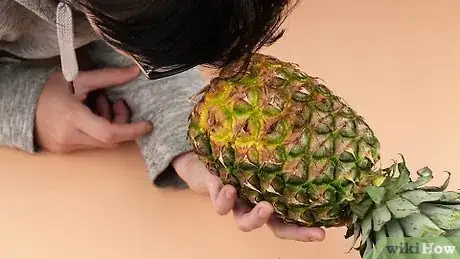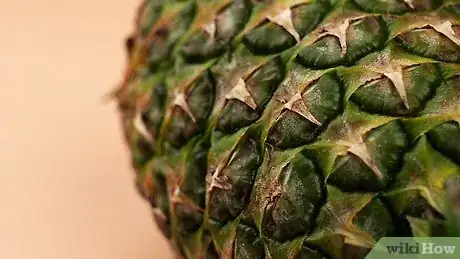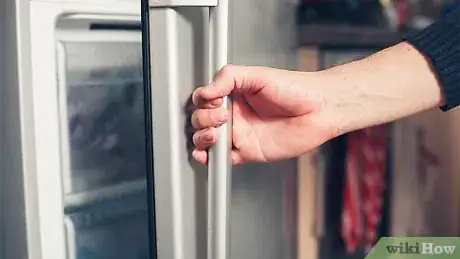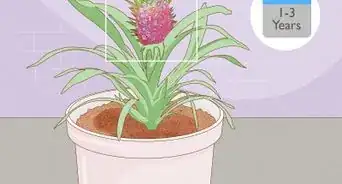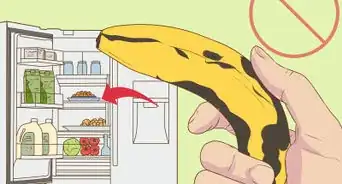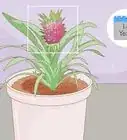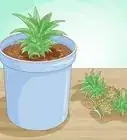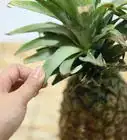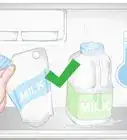This article was co-authored by Randall Chambers and by wikiHow staff writer, Aly Rusciano. Randall (Randy) Chambers is a Personal Chef and the Owner of Luxury Meals From Home based in Arvada, Colorado. He has more than 16 years of commercial kitchen experience, five years of sous chef experience, and two years of experience as an executive chef. Chef Randy draws inspiration from his half Bolivian background and his forte is South American cuisine. He holds an Associate’s degree in Culinary Arts from The Art Institute.
wikiHow marks an article as reader-approved once it receives enough positive feedback. This article has 22 testimonials from our readers, earning it our reader-approved status.
This article has been viewed 3,637,073 times.
Is there anything better than a juicy, sweet slice of pineapple? This bright, sunshiney fruit is fit for a day by the pool, but cutting it at the wrong time can turn your day upside down. So how do you know when a pineapple is ripe and ready to be eaten? We’ve laid out everything you need to know right here, so keep reading to learn how you can smell, feel, and see when a pineapple has reached ripened perfection.
Things You Should Know
- Sniff the bottom of a pineapple. If it smells sweet, it’s ready to eat!
- Squeeze a pineapple with your fingers. If it’s firm but moves ever-so-slightly, you can chop it up.
- Look to see if a pineapple has perky green leaves and a golden-yellow hue on the outside, which means it’s perfectly ripe.
Steps
Testing the Scent & Feel
-
1Does is smell sweet? Flip the pineapple over and sniff the bottom. If you smell something sweet, it’s ripe. If not, it’s probably not.[1]
- You can smell the pineapple on other sides too, but the strongest fragrance will come from the bottom or stem end.
- Throw out pineapples that smell fermented or like alcohol or vinegar, as they’re most likely bad.
-
2Is it squeezable? Hold the pineapple in your hand and gently press on it with your fingers. A ripe fruit will be firm but soft enough to bend under your fingers, specially in the bottom indentation.
- If the pineapple’s hard, it’s probably unripe.
- If the pineapple molds too easily in your hands, it may be rotten inside.
Advertisement -
3Is it heavy? A heavier pineapple usually means it’s juicy, and juice means it’s ripe and sweet. If the fruit feels hefty in your hands, it’s most likely ready to eat. This method isn’t foolproof, especially since pineapples come in all shapes and sizes, but it’s worth trying![2]
- This is a great way to pick between 2 pineapples at the store. Weigh each in your hands, and choose the heavier one.
- Note that “heavier” doesn’t mean “larger.” A ripe, smaller-sized pineapple might be as heavy (or heavier) than a larger, unripe pineapple.
-
4Do the leaves pluck right off? Now, this is a controversial method of testing ripeness, as some believe it works while others don’t, but it’s worth a try! Pull out the innermost center leaf. If that leaf removes easily, then the pineapple is ripe.
- Be careful because a leaf that slips out too easily may be rotten inside.
Visually Checking for Ripeness
-
1Is it golden-yellow in color? When pineapples ripen, their green or brown outsides start to turn a shade of yellow, especially near the base of the fruit. Even so, a green-tinted pineapple doesn’t automatically mean the pineapple isn’t ripe. Check to see if the pineapple has some yellow tones to it, as that may mean it’s time to cut it open.[3]
- Pineapples will start to change color on their base first. The more golden a pineapple is and the further the color rises towards the crown, the sweeter and riper it’ll be.
- Avoid pineapples with wrinkled or reddish-brown skin, as these are signs of rot.
-
2Are the leaves perky and green? A pineapple with droopy brown leaves is most likely overripe and not good to eat anymore. If the leaves are perky and green and there are other notes of ripeness, the fruit is most likely perfect to eat.
-
3Are the spikes flat against the fruit? The eyes or spikes around a ripe pineapple are flush with the fruit, not pointy. If the eyes are sharp and sticking out, the pineapple isn’t ready to be cut and eaten, so leave it on the shelf for a few more days.[4]
Storing
-
1Leave an uncut ripe pineapple at room temperature for 3 days. As long as you don’t cut the fruit, a pineapple can last on your countertop or in your fruit bowl for around 3 days. Just don’t try to stick it in the fridge, as this could cause it to ripen unevenly.[5]
-
2Store cut pineapple in the fridge for 3 to 4 days. When you’re ready to eat your pineapple, chop it up and place it in the refrigerator for about 4 days in an airtight container. This way, you can grab a fresh, sweet snack whenever you’d like![6]
- If your cut pineapple turns brown or slimy, it’s gone bad and should be tossed right away.
- To keep your pineapple fresh longer, chop off the rough exterior and store it in the fridge in an airtight container or wrapped in plastic wrap for up to a week.
-
3Freeze freshly cut pineapple for up to a year. Slice the pineapples into large chunks to retain as much flavor as possible. Then, place the pineapple chunks in freezer-safe plastic containers or freezer-safe plastic bags before storing them. The sooner you use them, the fresher they’ll taste.[7]
- Try freezing your pineapple pieces on a lined baking sheet before placing them in a freezer bag, so they don’t clump together.
- When you're ready to use the pineapple, remove it from the freezer and let it thaw at room temperature.
Our Most Loved Articles & Quizzes
Community Q&A
-
QuestionDo pineapples continue to ripen after picking?
 wikiHow Staff EditorThis answer was written by one of our trained team of researchers who validated it for accuracy and comprehensiveness.
wikiHow Staff EditorThis answer was written by one of our trained team of researchers who validated it for accuracy and comprehensiveness.
Staff Answer wikiHow Staff EditorStaff AnswerNo, for pineapples the ripening process halts after being picked. So if you get one that is too green there is not much you can do.
wikiHow Staff EditorStaff AnswerNo, for pineapples the ripening process halts after being picked. So if you get one that is too green there is not much you can do. -
QuestionIs pineapple used to tenderize meat?
 Community AnswerYes. Pineapple has a natural enzyme that breaks down protein, and it only takes a short time to tenderize meat this way.
Community AnswerYes. Pineapple has a natural enzyme that breaks down protein, and it only takes a short time to tenderize meat this way. -
QuestionCan I plant the top of the pineapple?
 Community AnswerYes you can! This is the most common way to plant pineapples. Check out How to Grow a Pineapple for more detailed information.
Community AnswerYes you can! This is the most common way to plant pineapples. Check out How to Grow a Pineapple for more detailed information.
Expert Interview
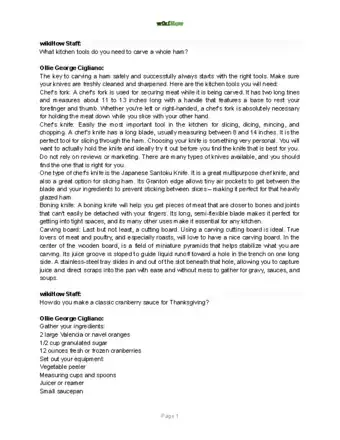
Thanks for reading our article! If you'd like to learn more about cooking with fruits, check out our in-depth interview with Ollie George Cigliano.
References
- ↑ http://hawaiiancrown.com/how-should-i-choose-a-ripe-pineapple-while-shopping-in-the-produce-department/
- ↑ https://www.bbcgoodfood.com/glossary/pineapple-glossary
- ↑ http://hawaiiancrown.com/how-should-i-choose-a-ripe-pineapple-while-shopping-in-the-produce-department/
- ↑ http://hawaiiancrown.com/how-should-i-choose-a-ripe-pineapple-while-shopping-in-the-produce-department/
- ↑ https://www.bbcgoodfood.com/glossary/pineapple-glossary
- ↑ https://www.luckybelly.com/does-pineapple-go-bad/
- ↑ https://www.luckybelly.com/does-pineapple-go-bad/
About This Article
To tell if a pineapple is ripe, first look at the color of its rind. The more yellow the rind is, the riper the pineapple will be. A pineapple that’s a golden-yellow color from top to bottom is perfect. If the rind is green, the pineapple isn’t ripe enough, but if it’s dark orange, the pineapple is too ripe. You can also tell if a pineapple is ripe by squeezing it. If the rind feels slightly soft, it’s ripe but if it’s tough and solid, the pineapple isn’t ripe enough yet. Finally, try smelling the bottom of the pineapple to see how ripe it is. If it smells fruity and sweet, it’s probably ripe but if it smells like vinegar, the pineapple is likely overripe. For tips on keeping a ripe pineapple fresh for longer, scroll down!
